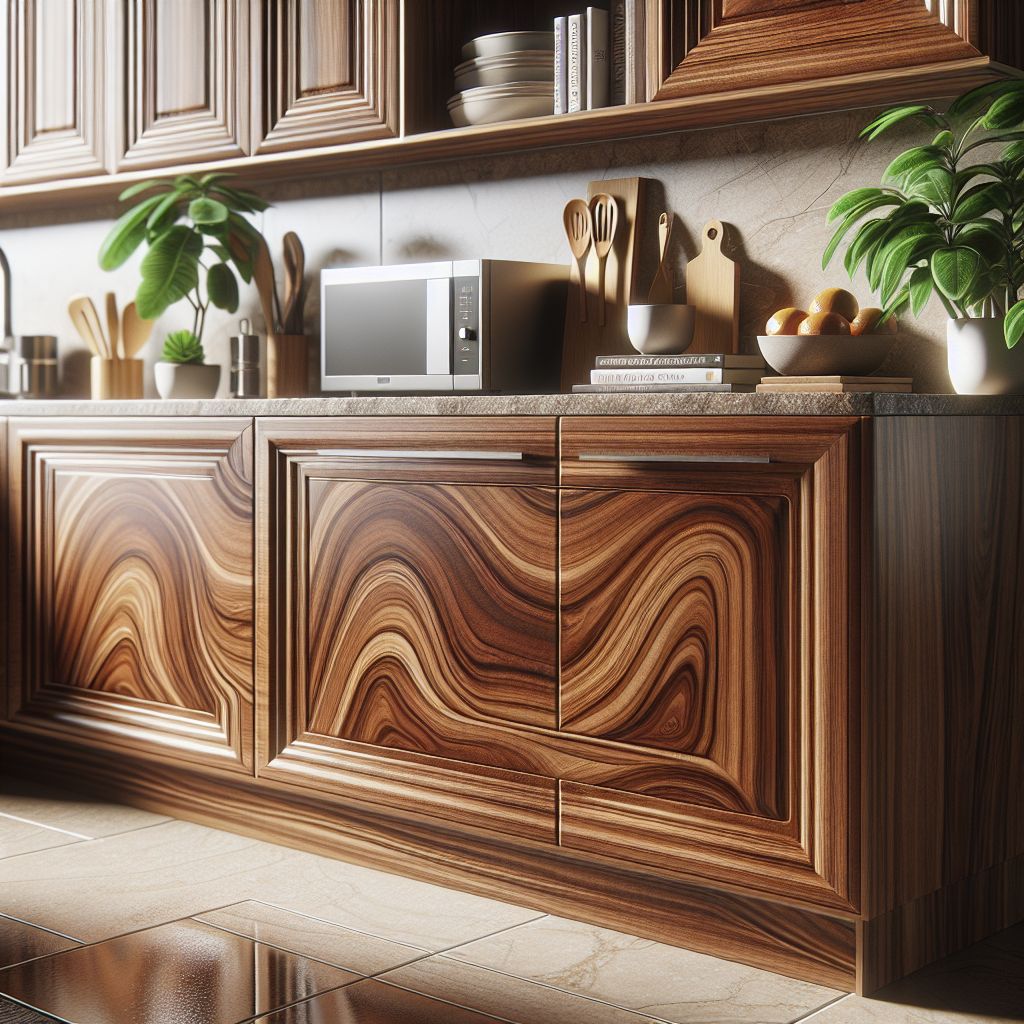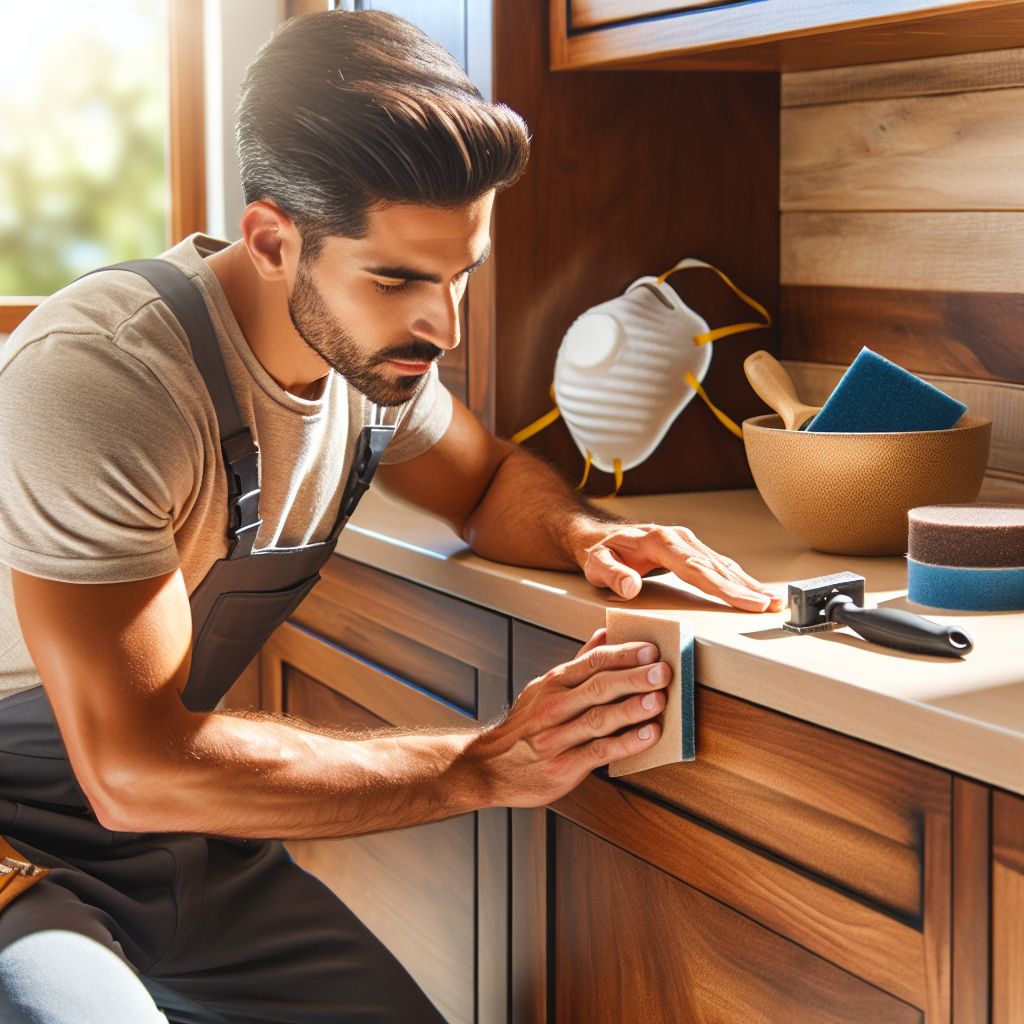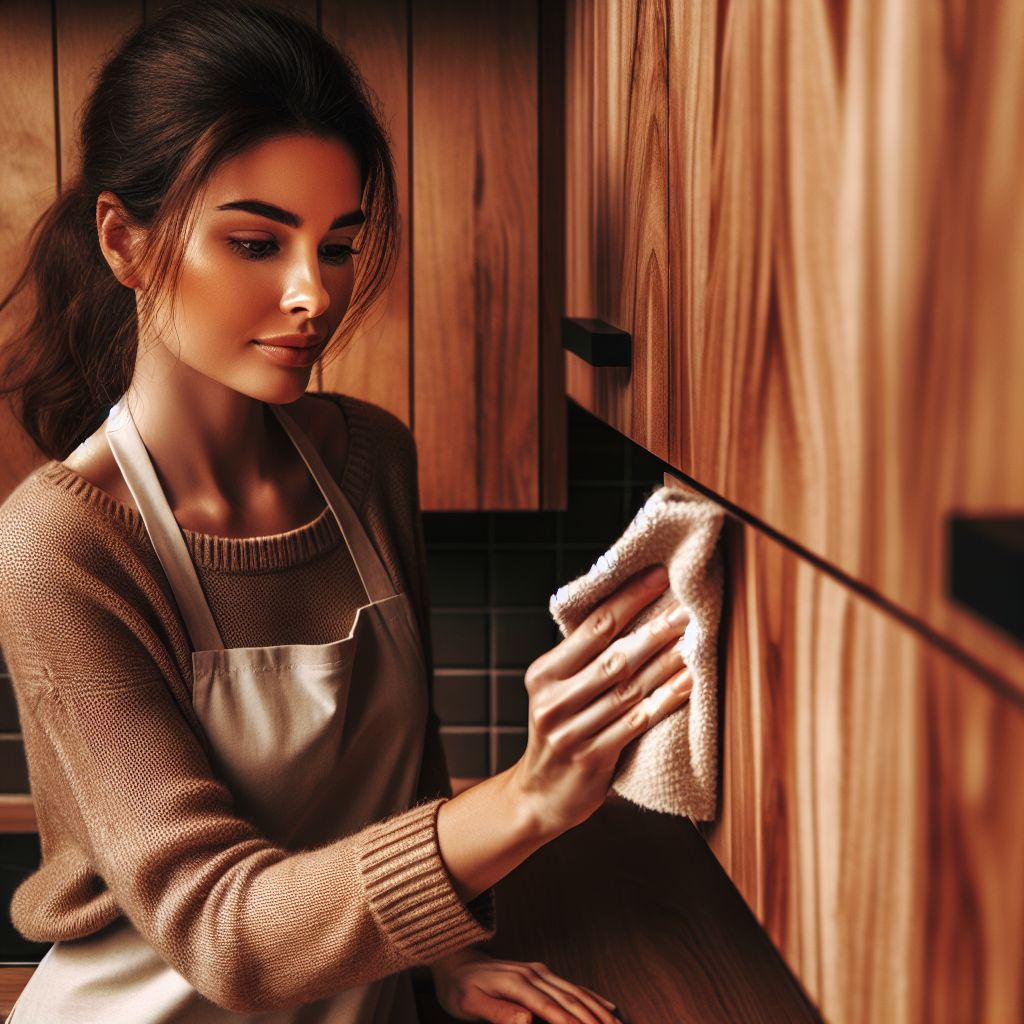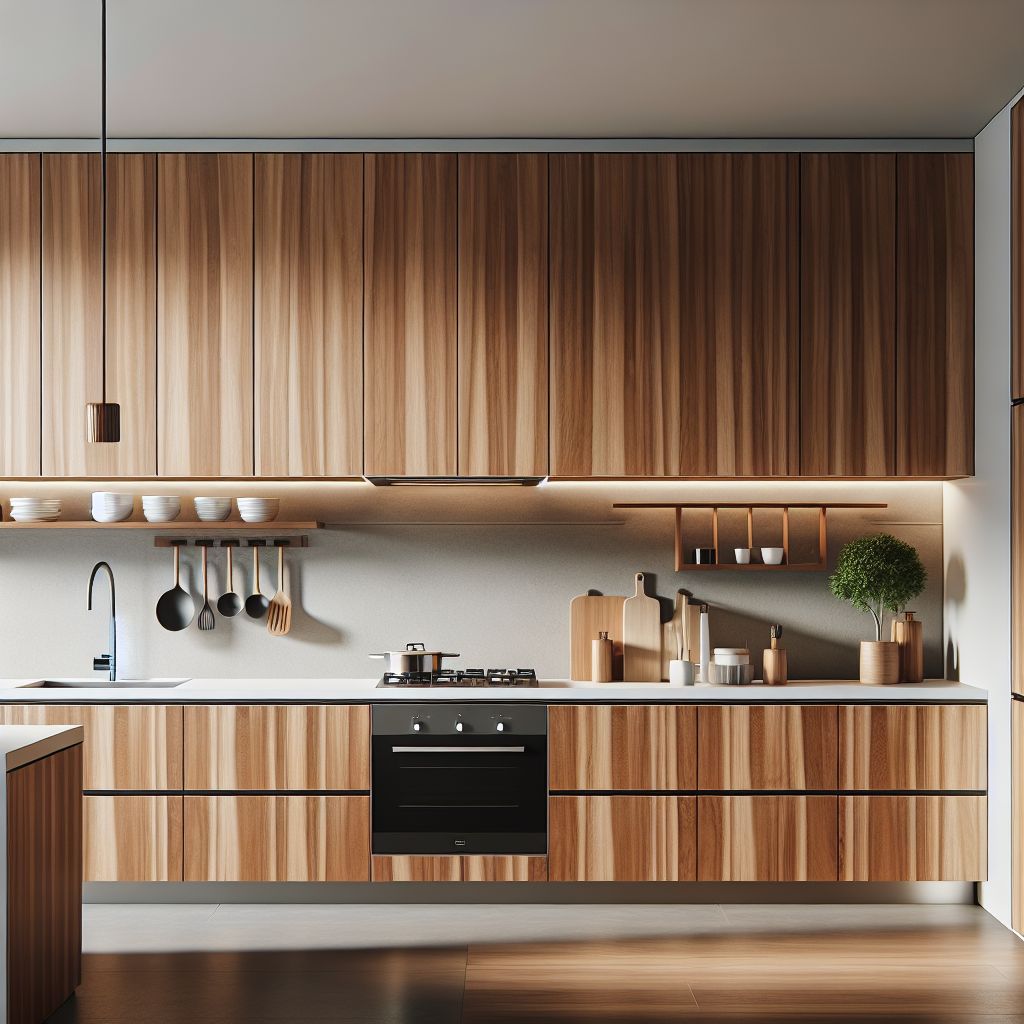
Key Takeaways
- Refinishing wood veneer cabinets is a cost-effective way to update your kitchen.
- Preparation is key – clean, assess, and repair veneer before refinishing.
- Choose the right tools and materials, including sandpaper, primer, and paint or stain.
- Follow a step-by-step process for best results: prep, sand, repair, prime, paint or stain, and seal.
- Maintain your refinished cabinets with gentle cleaning and avoiding harsh chemicals.
Transform Your Kitchen Cabinets with DIY Veneer Refinishing
Looking to give your kitchen a facelift without breaking the bank? Refinishing wood veneer cabinets is a brilliant way to breathe new life into your space. With a little elbow grease and the right approach, you can transform your outdated cabinets into something you’re proud to show off. Let’s roll up our sleeves and get started!
Your Cabinet’s New Lease on Life
First things first, it’s important to understand that veneer is a thin layer of real wood or a wood-like substance that’s applied to the surface of cabinets. It gives the appearance of solid wood without the hefty price tag. But, just like any other surface in your home, it can show signs of wear and tear over time. The good news? Veneer can be refinished.
What You’ll Need: Materials Checklist
Before diving into the project, you’ll need to gather all the necessary materials:
- Sandpaper (various grits)
- Wood primer (specifically for veneer surfaces)
- Paint or stain (your color choice)
- Paintbrushes or foam rollers
- Clear protective sealant (like polyurethane)
- Clean cloths and mild cleaner
- Screwdriver for hardware removal
- Wood putty (for repairs)
- Safety gear (gloves, mask, eyewear)
Gathering Your Tools and Materials
Now, let’s focus on what you’ll need to get the job done. This isn’t just about having a paintbrush in hand; it’s about being fully prepared with all the right tools and materials. This will ensure that your refinishing project goes smoothly and that the end result is something you can be proud of.
Selecting the Right Wood Veneer
Before we jump into the nitty-gritty of sanding and painting, take a moment to assess your cabinets and decide if you need to replace the veneer. If your current veneer is peeling or damaged beyond simple repairs, you might consider re-veneering the cabinets first. Choose a wood veneer that complements your kitchen’s style and color scheme. There are various types of veneer available, including peel-and-stick options that are user-friendly for DIYers.
Essential Tools for Refinishing
When it comes to refinishing, having the right tools is half the battle. Ensure you have quality sandpaper ranging from medium to fine grit to help you smoothly transition from stripping the old finish to preparing for the new one. A good primer is essential for a solid foundation, and when it comes to paint or stain, go for products designed for use on wood veneer. Don’t forget the sealant – this is your cabinet’s shield against everyday wear and tear.

DIY Refinishing Wood Veneer Kitchen Cabinet Steps
Ready to tackle the refinishing project? Roll up your sleeves and follow these steps.
Step 1: Preparing Your Cabinets for Refinishing
It all starts with preparation. Begin by removing all the hardware from your cabinets, including handles and hinges. Keep these pieces organized – you’ll thank yourself later. Next, give your cabinets a thorough cleaning with a mild cleaner to remove any grease, grime, and dust. Make sure to dry the cabinets completely with a clean cloth before moving to the next step.
This step is essential for the primer and paint to adhere properly.
Assessing the Veneer Condition
Once the cabinets are clean and dry, it’s time to assess the veneer’s condition. Look for any signs of wear, such as scratches, dents, or discoloration. If the damage is superficial, you can easily sand it out. However, if the veneer is warped, bubbled, or peeling, it may need to be repaired or replaced. Remember, a smooth and stable surface is key to a successful refinishing job.
Step 2: The Sanding Phase
Sanding is a critical step in the refinishing process because it helps to create a smooth base for the new finish to adhere to. It’s also the time to remove any old finish or paint, which will give you a fresh start. Always sand in the direction of the grain to avoid scratching the veneer. Start with a medium-grit sandpaper and finish with a fine-grit paper for a smooth surface.
For example, begin with a 120-grit sandpaper to strip away the old finish. Then, move to a 220-grit paper to smooth out the surface. Always wipe down the surface with a damp cloth between sanding to remove any dust.
Stripping Old Finish
If your cabinets have a thick layer of paint or varnish, you might need to use a chemical stripper before sanding. Apply the stripper according to the manufacturer’s instructions and scrape away the old finish. Always work in a well-ventilated area and wear protective gear when using chemicals.
Sanding Techniques for Smooth Surfaces
When sanding, use long, even strokes to avoid creating grooves in the wood. If you’re using an electric sander, keep it moving to prevent heat buildup, which can damage the veneer. Hand sanding gives you more control, especially around edges and detailed areas.
Step 3: Repairing the Damage
After sanding, take the time to repair any damage to the veneer. Fill small cracks or chips with wood filler and sand smooth once it’s dry. For larger areas of damage, you may need to replace sections of veneer. Cut the damaged section out carefully and glue a new piece of veneer in place. Once the repairs are complete, give everything one final sand for good measure.
Step 4: Applying the Primer
Priming is essential, especially for wood veneer. It helps to seal the wood and provide a uniform surface for the paint or stain. Apply a coat of primer designed for wood surfaces and let it dry completely. Depending on the type of primer, you may need to lightly sand the surface after the primer has dried to ensure a smooth finish.
Once the primer is on, take a step back and look at your cabinets. This is your last chance to catch any imperfections before adding color. Any spots that need attention should be sanded and primed again.
Choosing the Right Primer
Select a primer that’s compatible with your topcoat. If you’re painting, use a primer that works well with your chosen type of paint. For staining, choose a stain-blocking primer that will prevent any sap or tannins from bleeding through the finish.
Step 5: Painting or Staining: Achieving the Perfect Coat
Whether you’re painting or staining, apply your chosen finish with a brush or roller designed for smooth surfaces. Work in thin, even coats to prevent drips and streaks. If you’re painting, you’ll likely need at least two coats for full coverage. For staining, follow the manufacturer’s recommendations for application and drying time.
Best Practices for Painting Veneer
When painting veneer, opt for a semi-gloss or gloss paint which will be more durable and easier to clean. Always paint in the direction of the grain and allow ample drying time between coats. If you notice any drips or imperfections, sand them out before applying the next coat.
Applying the Stain
If you’re staining your cabinets, choose a stain that complements the wood’s natural color and grain. Apply the stain with a brush or rag, working it into the wood in a circular motion, then wiping away the excess with the grain. Multiple coats may be needed to achieve the desired depth of color.
Apply a wood conditioner to the cabinet surfaces if you’re using a stain. This helps the wood absorb the stain more evenly.
Step 6: Protective Finishes for Longevity
The last step in the refinishing process is to apply a protective finish. This will help to seal your cabinets and protect them from everyday wear and tear.
Sealants and Varnishes
Choose a sealant that’s appropriate for the level of use your cabinets will get. In a kitchen, you’ll want something that can stand up to heat and moisture. Polyurethane is a popular choice because it’s durable and comes in a variety of finishes, from matte to high gloss. Apply at least two coats with a brush or roller, and use smooth, even strokes to avoid bubbles and sanding lightly between coats for the smoothest finish.
With the sealant dry, you can reinstall your hardware. Take a moment to admire your work – your cabinets look brand new, and you did it all yourself. By following these steps, you’ve not only updated your kitchen but also added to the value and beauty of your home.

Common Mistakes to Avoid
As you embark on this DIY journey, be mindful of some common pitfalls. Skipping the sanding process can lead to a finish that peels or chips easily. Using the wrong type of primer or paint for veneer can result in a less than satisfactory outcome. Remember, patience is your ally here – rushing through the steps or not allowing enough drying time can spoil your hard work.
One mistake that can really set you back is not repairing damage before you start painting or staining. Any cracks or peeling veneer will only be magnified once the new finish is applied. Take the time to do it right from the start.
Finally, don’t underestimate the importance of a good sealant. It’s the armor that protects your cabinets from the wear and tear of kitchen life. Apply it carefully and evenly to ensure a lasting finish.
Insider Tips for a Flawless Finish
For a truly professional-looking finish, there are a few insider tips to keep in mind. Use a tack cloth to wipe down the cabinets after sanding – it’s much more effective than a regular cloth for removing fine dust particles. When painting, if you notice the paint isn’t leveling out as it should, add a paint conditioner to improve the flow and minimize brush marks.
Most importantly, don’t skimp on the quality of your materials. High-quality paints and primers may cost a bit more upfront, but they’ll save you time and money in the long run by providing better coverage and durability.
Post-Refinishing Maintenance Tips
After all the hard work you’ve put into refinishing your cabinets, you’ll want to keep them looking great. Clean them regularly with a soft cloth and mild soap – harsh chemicals can damage the finish. If you notice any chips or scratches, touch them up promptly to prevent further damage.
Be careful with water exposure, too. Prolonged moisture exposure can cause wood veneer to peel, so wipe up spills as soon as they happen. With proper care, your newly refinished cabinets will stay beautiful for years to come.

Frequently Asked Questions
Can you refinish veneer just like solid wood?
Yes, you can refinish veneer cabinets, but the process is slightly different. Because veneer is a thin layer of wood, you must be gentle during sanding to avoid sanding through the veneer. Always use fine-grit sandpaper and sand in the direction of the wood grain.
When you’re choosing your primers and paints, make sure to opt for options that are suitable for veneer surfaces. When painting, apply multiple thin coats rather than one thick coat, which will take longer to dry and may not dry evenly
With the right approach, refinishing veneer can give you results just as beautiful as solid wood.
What if the veneer is peeling or damaged?
If the veneer is peeling or damaged, you’ll need to repair it before you can refinish the cabinets. Small areas can be glued back down and clamped until dry. For larger areas, you might need to remove the damaged section and apply a new piece of veneer.
Remember, if the damage is extensive, it might be more cost-effective to replace the doors or drawers rather than attempting to repair them.
Always evaluate the extent of the damage before deciding on the best course of action.
Is it necessary to sand down to bare wood?
It’s not always necessary to sand down to bare wood when refinishing veneer cabinets. If the existing finish is in good condition and you’re not changing the color dramatically, a thorough sanding to scuff up the surface might be enough. However, if you’re applying a stain or want to ensure the new paint adheres well, sanding down to the bare wood is recommended.
How long should I wait between coats?
Waiting time between coats can vary depending on the product you’re using and the humidity levels in your home. As a general rule, wait at least 24 hours between primer coats and at least 4-6 hours between paint coats. For stain, follow the manufacturer’s instructions, as some may require longer drying times.
Always check the surface to make sure it’s completely dry before applying the next coat.
Can I change the color of my cabinets when I refinish?
Yes, one of the great benefits of refinishing your cabinets is the ability to change their color. Whether you want a bold new look or a subtle change, paint and stain can make a dramatic difference. Just be sure to use a primer that will block any previous colors from bleeding through, especially if you’re going lighter.





Leave a Reply